Excerpts from Jim Conrad's
Naturalist Newsletter

from the December 28, 2014 Newsletter issued from Río Lagartos, on the Yucatan Peninsula's northern coast (~N21.60°, ~W88.16°), Yucatán state, MÉXICO
BLACK MANGROVE
In our area the swampy mangrove forests surrounding the estuary are composed of four species. You may want to review them on our Mangrove Page at www.backyardnature.net/yucatan/mangrov2.htm.
The main mangrove species along the usually flooded shore is the Red Mangrove, the one with multiple, "stilt-roots" descending from the tree's main branches, sprouting multiple roots on the way down before plunging into water. However, in some places another mangrove species dominates the estuary margins, in which case the stilt roots are replaced by thickets of slender, grayish, fingerlike poking up from the water. These are pneumatophores, which help the tree acquire air. The tree producing the pneumatophores is the Black Mangrove, AVICENNIA GERMINANS, a member of the mostly tropical Acanthus Family, the Acanthaceae. A Black Mangrove with pneumatophores at the estuary's edge is shown above.
A close-up of pneumatophores emerging from mud at low tide is shown below:
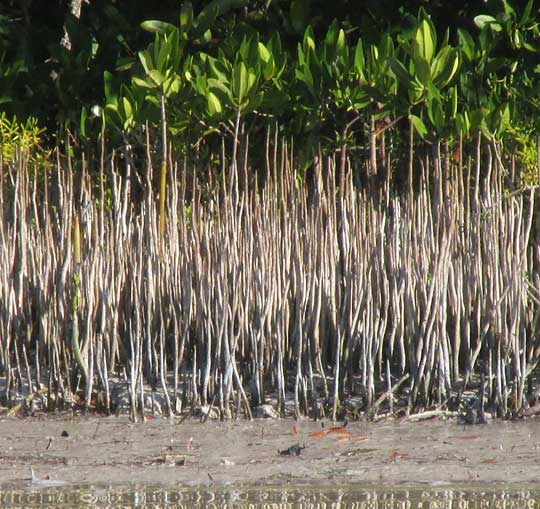
Black Mangrove leaves are simple, evergreen and leathery, and arise two per stem node (opposite). The leaves, smaller than those of Red Mangrove, are shown below:
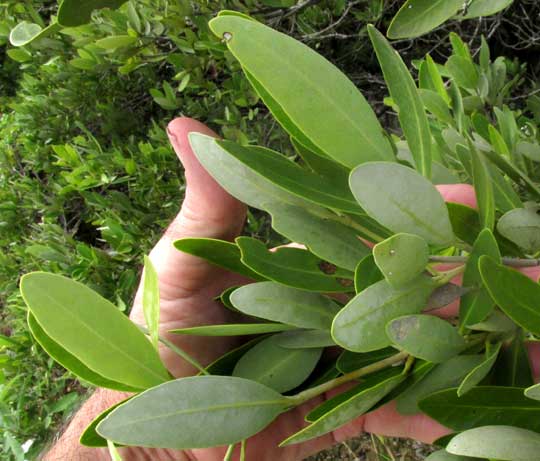
The leaf bases opposing one another on the stem are shown below:
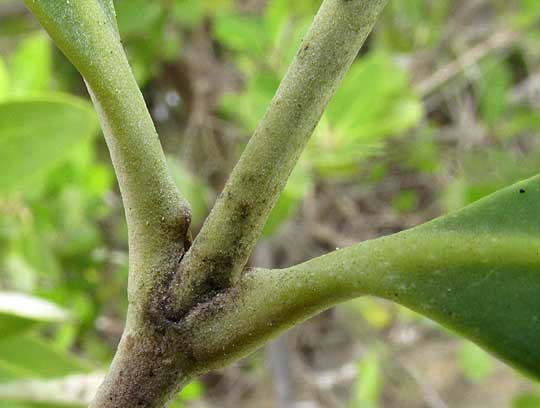
One feature to notice in that picture is that no salt-excreting glands appear on the petioles at the blade bases, as with the White Mangrove and Buttonwood, which are two of our four mangrove species. This lack of petiole glands helps distinguish Black Mangrove from those two species while the lack of stilt roots and presence of pneumatophores separate it from the Red Mangrove. All mangrove species have special adaptations for dealing with salt in the brackish water they live in. Black Mangrove's way of dealing is to expel it from the surfaces of its leathery leaves.
The Black Mangrove's trunk isn't black, but its heartwood is blackish. The bark is a little dusky, though, as shown below:
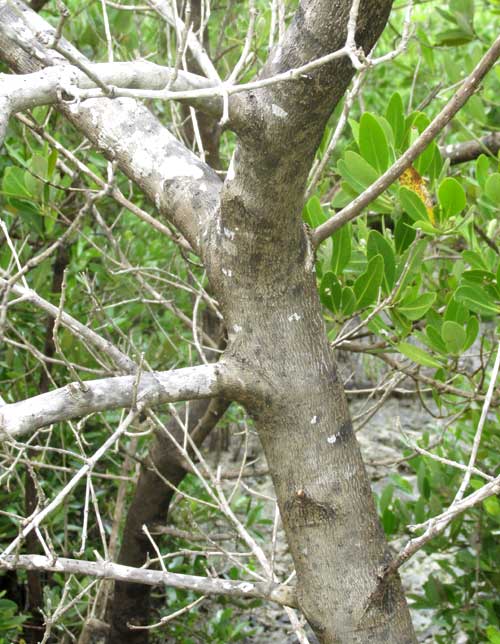
Of our four mangrove species, Red Mangrove usually occupies the deepest water, and normally as the water becomes shallower Red Mangrove give way to Black Mangrove. White Mangrove and Buttonwood live on often exposed ground, with Buttonwood typically in the driest places, often forming the mangrove forest's outer border. All four mangrove species work together to stabilize the shoreline, provide buffers from storm surges, trap debris and detritus brought in by tides, and provide feeding, breeding, and nursery grounds for a huge variety of fish, shellfish, birds, and other wildlife.
Black Mangrove occurs in tropical and subtropical regions of the Americas on both the Atlantic and Pacific coasts, and on the Atlantic coast of tropical Africa. In the US it reaches coastal areas of Texas and Florida, and even southern Louisiana and coastal Georgia.
from the May 10, 2015 Newsletter issued from Río Lagartos, on the Yucatan Peninsula's northern coast (~N21.60°, ~W88.16°), Yucatán state, MÉXICO
BLACK MANGROVES FLOWERING
Nowadays the Black Mangroves are flowering, as you can see below:
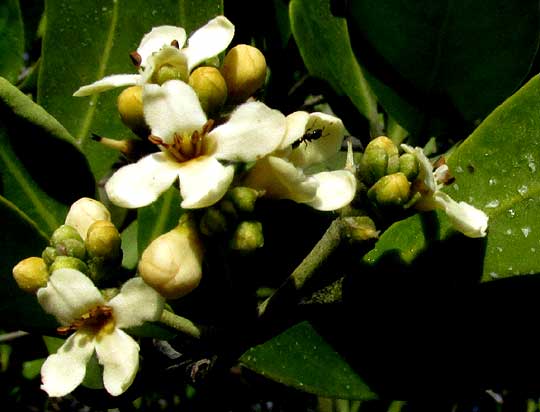
Before getting to that picture's flowers, notice the white flakes of salt on the leaf at the picture's right. That's how Black Mangrove rids itself of some of the salt it takes in through its roots -- by expelling it through its leaves. Lick the leaf and it tastes salty.
With regard to the flowers, notice how the blossoms are bunched in clusters at the tips of inflorescence branches that fork in a Y-shaped manner -- "dichotomously," as botanists say when the branches are equal on both sides. Below, you can better see an individual flower's bilateral symmetry:
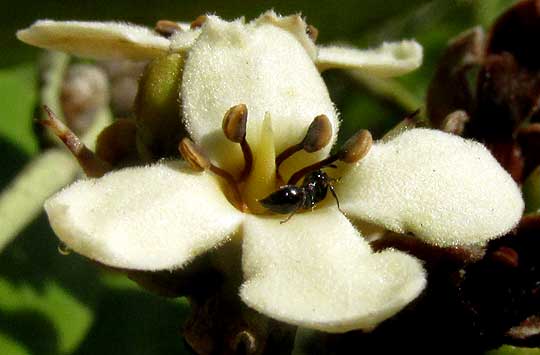
The flower is bilaterally symmetrical, not radially, because there's only one way you can cut across the corolla so that mirror images occur on both sides -- and that's vertically. If you'd cut it horizontally, you'd end up with all four of the brown, spoonlike stamens on the corolla's top half and none on the bottom. Eventually the fruit will be asymmetrical, too, and you can see in the picture that the rhinoceros-horn-shaped style atop the ovary is tilted upward, and thus also asymmetrical. Actually, the style is not sharp pointed as it seems in the picture. It's tipped with two stigma lobes that on our flower are held together forming a sharp tip; later the lobes will open up, forming a Y.
With such floral features, traditionally botanists have placed Black Mangrove in the Verbena Family, the Verbenaceae. Some think the genus is so unusual, though, that they assign it to its own Black Mangrove Family, the Avicenniaceae. However, modern genetic analysis finds that it fits best in the Acanthus Family, the Acanthaceae. Nowadays authorities are about as likely to put it in one family as another.
In the picture, the ant on the flower is not incidental. Especially now during the late dry season, many insects have a hard time finding non-salty water. V. Rico-Gray in his 1989 study, "The importance of floral and circum-floral nectar to ants inhabiting dry tropical lowlands," finds that "... during the dry season in coastal Yucatan, ants will rely on the nectar produced on the flowers and other reproductive structures as their main liquid energy source." He further points out that in Black Mangrove flowers ants don't pollinate the blossoms, so the ant in the picture is engaged in "nectar thievery."